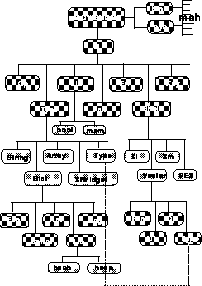




Next: MetaDictionary
Up: 17.2 System Overview
Previous: 17.2.8 ``In Large'' Extensibility
MOVIE Server is a large C program and it requires appropriate software
engineering tools for its development.
Commercial software systems are usually developed in terms of
sophisticated commercial CASE tools. In the academic environment, one
rarely builds large production systems and one usually uses simpler,
lower level tools based on dialects of the UNIX shell, most typically
the C shell which forms now the standard text-mode UNIX interface on
most workstations. The C-shell-based environment is most natural in the
research working mode where the code is usually of small or moderate size,
its typical lifetime is short, and it undergoes a series of major changes
during the development cycle. These changes are often of unpredictable
character and hence difficult to parametrize a priori in the form of
some high-level CASE tools.
MOVIE project aims at the large, commercial quality production system,
and yet it is created in the academic environment and contains
substantial research components in the domain of HPDC. We therefore
decided to select a compromise strategy and to start the MOVIE Server
development process in terms of simple, custom-made, C-shell-based CASE
tools. More explicitly, the current generation of CASE tools for MOVIE
is structured as the interpreter of a very simple high level
object-oriented language called MetaShell, designed as a superset of the
C-shell. In this way, we assure the compatibility with the standard
academic environment and, at the same time, we provide somewhat more
powerful software development tools than those offered by the plain
text-mode UNIX environment.
A more functional language model for the CASE tools in MOVIE would be
provided by the MovieScript itself due to its high-level features and
the built-in GUI support but we need a consistent bootstrap scheme in
such a process. A natural approach is to use C shell to build MOVIE 1.0,
then use its MovieScript to build MOVIE 2.0, and so on. Alternatively, we can
consider the task of building high-quality visual ``intelligent'' CASE
tools as one of the MOVIE 1.0-based application projects. We discuss
these future plans is Section 17.2.10 and here we present the current
MetaShell model from the MOVIE developer's point of view. The detailed
technical documentation of the MetaShell tools can be found in
[Furmanski:92c].

Figure: Sample Elements of the $MOVIEHOME Directory Tree. Dark blobs
represent system nodes/names, shaded blobs represent user-provided
nodes/names within the M-tree model. For example, each new type, such as
Dict, automatically generates its subtree containing the following
directories: Fcn (low-level object functions, used for implementing
other object components), Act (object-dependent methods for
polymorphic operators), Msg (methods implementing object messages),
Const (predefined default instances of a given type), Lib,
and (C libraries of object functions).
The entire code volume associated with MOVIE is stored in the directory
$MOVIEHOME, shown in Figure 17.8 installed as the UNIX
environment variable and used as the base pathname for the MetaShell
addressing modes. The most relevant nodes in this directory are:
bin, sys, and M. The bin directory, to be
included in the developer's path, contains the external binaries such
as the main MetaShell script and the MOVIE Server binary. The sys directory contains diverse system-level support tools-for
example, the C and C-shell code implementing the MetaShell model. The
server code starts in the subdirectory M and we will refer to the
associated directory tree, starting at M, as the M-tree.
M branches into a set of base software categories such as, for example:
Op (C or MovieScript source files implementing methods for the
MovieScript operators), Lib (C language libraries), Err
(MovieScript error operators), Key (system name objects),
Type ( MovieScript types), Shell (MovieScript shell objects)
and so on.
Some of these nodes are simple, that is, they contain only a set of regular
files (e.g., M/Op); some are composite, that is, they branch further
into subdirectories (e.g., M/Lib which branches into system libraries).
In the current implementation, the maximal branching level is five (e.g.,
directory M/Type/String/Lib/regex, which contains the string type
library functions for handling regular expressions). Many structural aspects
of the system can be presented in the form of some suitable M-tree
mappings, listed below:





Next: MetaDictionary
Up: 17.2 System Overview
Previous: 17.2.8 ``In Large'' Extensibility
Guy Robinson
Wed Mar 1 10:19:35 EST 1995





